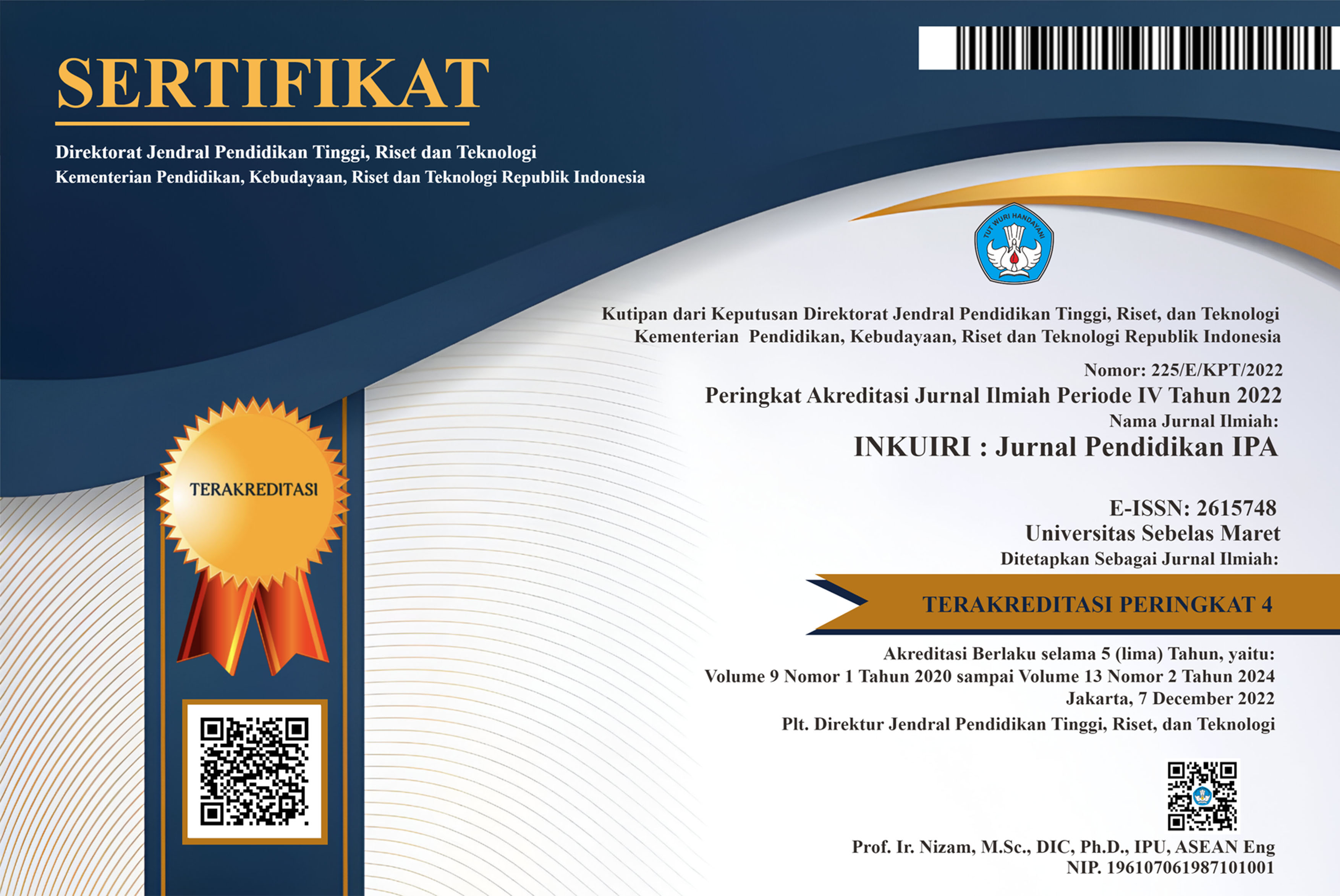MENYELIDIKI ENERGI PADA FOTOSINTESIS TUMBUHAN
Abstract
Cahaya matahari memiliki sifat polikromatik bila dibiaskan akan menghasilkan cahaya-cahaya monokromatik. Cahaya-cahaya monokromatik inilah yang ditangkap oleh klorofil dan digunakan dalam proses fotosintesis. Dalam suatu percobaan diketahui bahwa gelombang cahaya biru dan cahaya merah adalah yang paling efektif dalam melakukan proses fotosintesis. Kesimpulan: 1). Gelombang cahaya biru dan cahaya merah adalah yang paling efektif dalam melakukan proses fotosintesis. Cahaya merah mempunyai energi foton 1.65-2.00 eV, sedangkan cahaya biru mempunyai energi foton 2.5-2.75 eV. 2). Pada fotosintesis terdapat dua reaksi yaitu reaksi terang dan reaksi gelap. Reaksi terang terjadi Pemecahan air (H2O) menjadi ion Hidrogen (H+) dan molekul air menggunakan energi cahaya, menghasikan O2, ATP, dan NADP H2. Reaksi gelap terjadi pengikatan karbondioksida (CO2) dan mengkombinasikannya dengan ion hidrogen (H+) sehingga membentuk gula. 3). Dalam fotosintesis berlaku hukum kekekalan energi yaitu Energi radiasi sinar matahari ditangkap oleh klorofil kemudian diubah menjadi energy kimia melalui proses fotosintesis. Dalam hal ini tidak ada energi yang musnah. Energy kimia tersebut digunakan untuk mensintesis CO2 dan H2O menjadi glukosa dan senyawa kompleks lainnya yang tersimpan dalam bentuk senyawa karbohidrat.
Sunlight has polychromatic properties when refracted will produce monochromatic light. This monochromatic light is captured by chlorophyll and used in the process of photosynthesis. In an experiment it was found that blue light and red light are the most effective in carrying out photosynthesis. Conclusion: 1). Blue light and red light are the most effective in carrying out photosynthesis. Red light has a photon energy of 1.65-2.00 eV, while blue light has a photon energy of 2.5-2.75 eV. 2). There are two reactions in photosynthesis, namely the light reaction and the dark reaction. The light reaction occurs The splitting of water (H2O) into Hydrogen ions (H+) and water molecules using light energy, producing O2, ATP, and NADP H2. The dark reaction occurs when carbon dioxide (CO2) is bound and combines with hydrogen ions (H+) to form sugars. 3). In photosynthesis, the law of conservation of energy applies, namely the energy of solar radiation captured by chlorophyll and then converted into chemical energy through the process of photosynthesis. In this case no energy is lost. The chemical energy is used to synthesize CO2 and H2O into glucose and other complex compounds that are stored in the form of carbohydrate compounds.
Keywords
Full Text:
PDFReferences
Elida Purba, Ade Citra Khairunisa. 2012. Kajian Awal Laju Reaksi Fotosintesis untuk Penyerapan Gas CO2 Menggunakan Mikroalga Tetraselmis Chuii. Jurnal Rekayasa Proses, Vol. 6, No. 1,
Muhammad Mansur, Nuril Hidayati, Titi Juhaeti. 2011. Struktur dan Komposisi Pohon Serta Estimasi Biomassa, Kandungan Karbon dan Laju Fotosintesis di Taman Nasional Gunung Halimun Salak. Jurnal J.Tek. Ling. 12 (2): 161 - 169
Nio Song Ai. 2012. Evolusi Fotosintesis Pada Tumbuhan. Jurnal Ilmiah Sains Vol. 1
Loveless, A.R. 1991. Principles of Plant Biology for the Tropics. Logman Group Limited.
Papib Handoko, Yunie Fajariyanti. 2015. Pengaruh Spektrum Cahaya Tampak Terhadap Laju Fotosintesis Tanaman Air. Seminar Nasional X: FKIP UNS
Salisbury, F. B dan C. W. Ross. 1995. Fisiologi Tumbuhan jilid 2. Terjemahan dari Plant Physiology 4th Edition. Bandung: ITB
Rani Oktavia.http://literacyofscientific.blogspot.com/2014/10/ fotosintesis-ditinjau-dari-ilmu-biologi.html?m=1/. Diakses pada Kamis, 22 November 2018 pukul 19.45 WIB.
https://idslide.net/view-doc.html?utm_source=bab-7-hukum-kekekalan-energi. Diakses pada Sabtu, 10 November 2018 pukul 07:42.
Refbacks
- There are currently no refbacks.






